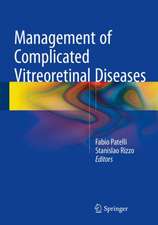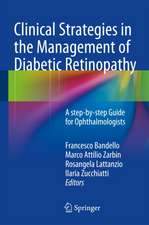Myopia Updates: Proceedings of the 6th International Conference on Myopia
Editat de Takashi Tokoroen Limba Engleză Hardback – 14 sep 1997
| Toate formatele și edițiile | Preț | Express |
|---|---|---|
| Paperback (1) | 374.78 lei 6-8 săpt. | |
| Springer – 19 apr 2014 | 374.78 lei 6-8 săpt. | |
| Hardback (1) | 382.99 lei 6-8 săpt. | |
| Springer – 14 sep 1997 | 382.99 lei 6-8 săpt. |
Preț: 382.99 lei
Preț vechi: 403.15 lei
-5% Nou
Puncte Express: 574
Preț estimativ în valută:
73.29€ • 76.24$ • 60.51£
73.29€ • 76.24$ • 60.51£
Carte tipărită la comandă
Livrare economică 15-29 aprilie
Preluare comenzi: 021 569.72.76
Specificații
ISBN-13: 9784431701996
ISBN-10: 4431701990
Pagini: 428
Ilustrații: XIV, 411 p.
Dimensiuni: 155 x 235 x 28 mm
Greutate: 0.77 kg
Editura: Springer
Colecția Springer
Locul publicării:Tokyo, Japan
ISBN-10: 4431701990
Pagini: 428
Ilustrații: XIV, 411 p.
Dimensiuni: 155 x 235 x 28 mm
Greutate: 0.77 kg
Editura: Springer
Colecția Springer
Locul publicării:Tokyo, Japan
Public țintă
ResearchDescriere
The first International Conference on Myopia was sponsored by the Myopia Interna tional Research Foundation in New York City in 1964. The second conference was held in San Francisco in 1984, the third in Rome in 1986, the fourth in Singapore in 1990, and the fifth in Toronto in 1994. The conferences were held every four years as satellite meetings within the Interna tional Congress of Ophthalmology. In recent years, however, the incidence of myopia throughout the world and the mechanisms of myopia have been has increased rapidly studied by many researchers using animal models. Against this background, at the fifth conference, held in Toronto in 1994, it was decided to hold the International Conference on Myopia every two years. I am honored that the organizing committee selected me as the host for the sixth International Conference on Myopia. Progress in the field in the two years between the fifth and the sixth Interna tional Conferences on Myopia, has been astounding. Although the mechanisms of myopia have not been clarified, many questions concerning myopia are arising from disciplines representing the entire spectrum from clinical findings to molecular biology. Thus, in the sixth International Conference on Myopia, the program provided for discussion of a wide variety of subjects, including epidemiology, pathogenesis, experimental myopia, and treatment. A number of doctors from Asian countries, where the incidence of myopia is especially high, reported on recent epidemiology in their countries.
Cuprins
Plenary Lectures.- Epidemiology of Myopia: Scandinavian and Hong Kong Experiences.- How Is Emmetropization Controlled? Results of Research on Experimental Myopia.- Honorary Lecture.- Pitfalls of Ignoring Refractive Emmetropization.- Epidemiology.- Two-Year Longitudinal Changes in Refractive Errors and Optical Components Among a Group of Chinese Factory Workers.- Various Etiopathological Studies of Simple Myopia.- Studies of Genetic and Environmental Factors in the Occurrence of Myopia Based on Epidemiologic Data.- Study of Myopia in the People’s Republic of China.- A Longitudinal Study of the Development of Myopia in Chinese Children: A Life Table Treatment.- Correlation Between Ocular Refractions with Longitudinal Study Among Schoolchildren in Taiwan.- Development of Instruments to Measure Near Work in Myopia Studies.- Relationship Between Posture and Myopia Among Students.- Prevalence and Patterns of Myopic Progression Among Schoolchildren: Eight-Year Longitudinal Study.- Risk Factors for Refractive Errors in Preschool Children.- Prevalence of Myopia in Schoolchildren and Risk Factors for Its Progression.- Longitudinal and Cross-Sectional Study of Refractive Changes in Pupils from 3 to 17 Years of Age.- Study of Myopia in Infants.- Changes in the Crystalline Lens in Schoolchildren Aged 6 to 16 Years.- Insufficient Accommodation and Near Esophoria: Precursors or Concomitants of Juvenile-Onset Myopia?.- Pathogenesis.- Clinical Features in High Myopia: A 30-Year Follow-up of a Representative Sample.- Changes of Anterior Segment in Myopic Eyes: Analysis with Scheimpflug System.- Uniocular Diplopia in Myopic Eyes.- A Computed Tomographic Study of the Relation Between Ocular Axial Biometry and Refraction.- Investigation of Normal and Myopic Eyes by Computer Tomography.- Results of Biochemical Investigations of Congenital Myopia in Children.- Collagen Fibril Diameter and Cross-Band Interval of Myopic Eye Sclera.- Antibodies to Collagen in Patients with Progressive Myopia.- Acute Transient High Myopia in Systemic Lupus Erythematosus Associated with Steroid-Induced Glaucoma.- Infrared Radiation Influence on an Eye with Progressive Myopia.- Myopic Macular Holes Have Various Epiretinal Membranous Structures with Posterior Vitreous Detachment.- Clinical Factors Affecting Ocular Axial Length in Patients with Unilateral Myopia.- Treatment.- Possibility of Using None-Cholinergic None-Adrenergic Chemicals as Therapeutics of Myopia.- Muscarinic Antagonists for Myopia Control.- In Search of Excellence: From Radial Keratotomy to Laser-Assisted In Situ Keratomileusis.- Laser In Situ Keratomileusis (LASIK) for Myopia.- Histochemical and Immunohistochemical Studies of Rabbit Corneas After Photorefractive Keratectomy.- Singapore Myopia Treatment Study: Asian RGP Contact Lens.- Rigid Gas-Permeable Contact Lenses in the Control of Myopia Progression.- Simple Myopia with an Indigenous Drug (Clinical Study).- Long-Term Treatment of Myopia with Atropine.- Instrument-Induced Changes in Refraction in a Pediatric Clinical Series Has Corneal Curvature a Role to Play?.- Long-Term Effectiveness of Scleral Reinforcement in Children with Difficult Progressive Myopia.- A New Composition for the Treatment of Progressive Myopia and Its Efficiency.- Effectiveness of Magnetopuncture for Treatment of Myopia.- Scleroplasty Using the Explant with Trypsin Inhibitor.- Posterior Radical Vitrectomy for the Arrest of Progressive Myopia (16-Year Follow-up).- Multiple Optical Zone Photorefractive Keratectomy with the Visx Twenty/Twenty Excimer Laser: Clinical Trial.- Experimental Myopia.- Neural Mechanisms and Eye Growth Control.- Myopia Development as a Result of Visual Deprivation? Systems Analysis and Possible Biochemical Correlates.- Blood-Retinal Barrier in Experimental Myopia.- Structural and Metabolic Changes Associated with Recovery from Experimentally Induced Myopia: A Brief Review.- Levels of Control in the Refractive Development of the Eye: Evidence from Animal Models.- Relationship Between Choroidal Blood Flow and Myopia.- Scleral Changes and Melatonin in Form-Deprivation Myopia.- Roles of Growth Factors and Retinoic Acid in Experimental Myopia.- Local Ocular Compensation of Locally Imposed Refractive Errors Despite Accommodation?.- The Influence of Growth on Experimental Myopia in Tree Shrews.- Gender Differences in Tree Shrew Eyes with Growth and Experimental Myopia.- Cylindrical Spectacle Lenses Alter Emmetropization and Produce Astigmatism in Young Monkeys.- ERG of Lens-Induced Versus Form-Deprivation Myopia in Chicks.- Changes in the Morphology of Choriocapillaris on Experimental Chick Myopia.- Isolation of mRNA Species Enriched in the Ocular Tissues of Form-Deprived Chick Eyes Using Differential Display.- Plasminogen Activator: Influence on Axial Length in Chick Eye.- Light-Driven Rhythms in Scleral Precursor Synthesis.- Others.- Variation in Accommodative Aftereffect Due to Age of Onset of Myopia.- Myopia Adults See Through Defocus Better Than Emmetropes.- Effects of Resting State of Accommodation Regarding Prescription for Contact Lenses and Glasses.- Blur of Eye Movement as a Stimulus to the Development of Myopia.- Correlation Between Steroid Hormone Balance and Etiopathology of High Myopia: Clinical Trial.- Corneal and Lens Autofluorescence in Myopia.- Electrophysiological Changes in Photopic Function in Myopia.- Sensitivity of Chorioretinal Atrophic Lesions in High Myopia Detected by Scanning Laser Ophthalmoscope Microperimetry.- Posterior Routes of Choroidal Venous Flow in High Myopia.- High Myopia and Indocyanine Green Angiography. An Analysis of Subjects Aged 47 Years with Anisomyopia.- Key Work Index.










